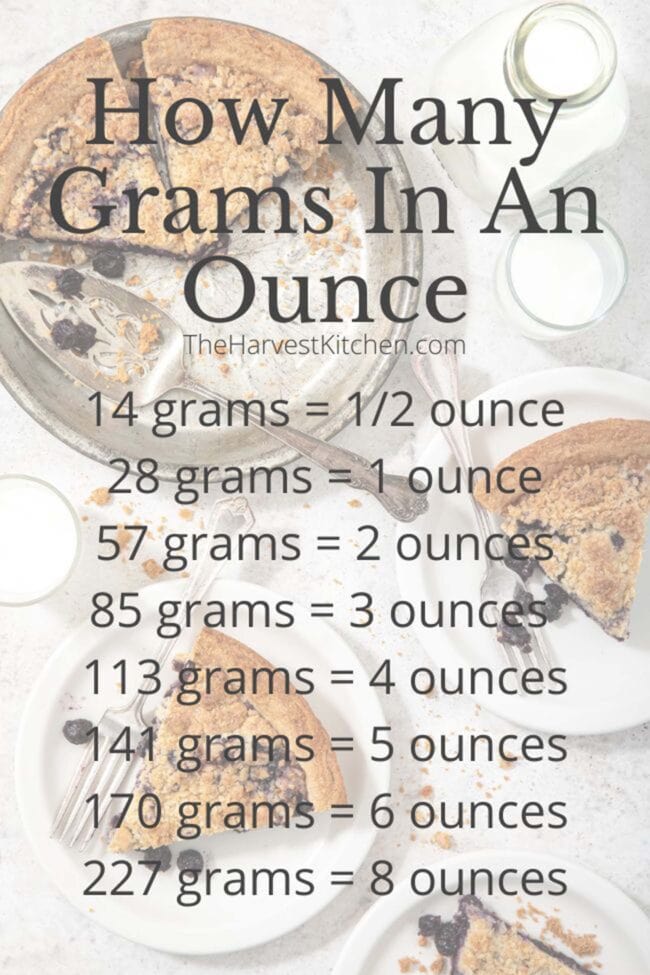How Many Grams in an Ounce
Here’s everything you need to know about how to convert grams to ounces (grams to ounces or ounces to grams). How many grams in an ounce and what is a gram(g) and what is an ounce (oz)? I’ve also provided you with an easy conversion chart below to help you memorize these conversion

Being successful in the kitchen requires the accurate measurement of ingredients. When following recipes to make a meal, you might be able to eyeball the amount of herbs and spices and other simple ingredients, but if you add too much or too little of an ingredient, the outcome of your recipe might not be what you had hoped for. Knowing how many grams in an ounce is a helpful liquid measurement conversion to have memorized for achieving success in the kitchen.
How Many Grams Are In An Ounce
There are 28 grams in 1 ounce
- 1 ounce = 28 grams
- 1/2 ounce = 14 grams
- 1/4 ounce = 7 grams
What Is A Gram
A gram (also spelled gramme and abbreviated as “g”) is a metric unit of measurement used to define weight and mass of liquid or dry ingredients. One gram is equal to one-thousandth (1/1000) of a kilogram.
How Much Is A Gram
The amount of a gram is actually very small. For instance 1 gram of salt or sugar equals about 1/4 teaspoons (o.24 to be precise).
This visual will help you the next time you’re checking the nutrition labels while shopping at the grocery store. You’ll be able to better gauge how much salt, sugar or fat a product contains. For instance 4.2 grams equals 1 teaspoon and 15 grams equals 1 tablespoon. This information will help you make healthier purchasing choices if you’re watching your sugar, salt or fat intake.
How to Measure Grams
You can use measuring spoons or cups to estimate the measurements, but for accurate measurements you’ll need to use a kitchen scale.
Place a measuring cup or mixing bowl on top of your digital scale and hit the “zero” or “tare” button. This will take into account the weight of the bowl and set the scale counter back to zero. Then just add your ingredient (flour, sugar, etc) into the bowl to measure the accurate amount called for in your recipe.
What Is An Ounce
Ounce is used in the U.S. and Britain to measure the “weight” of something (like flour and sugar). The word “ounce” comes from the Latin word “unica” meaning “one-twelfth” and it was abbreviated as “oz” back in the 1500s. The abbreviation “oz” comes from the Italian word “onza”, which also means “ounce”.
What is a Fluid Ounce
“Fluid ounce” (fl oz or fl. oz.) is from the Imperial and U.S. Customary System measurements system that is used in the measurement of the volume of liquid ingredients (like milk, water or juice). The term fluid ounce is often abbreviated as fl. oz or fl oz, which means either a single fluid ounce or fluid ounces (both “ounce” and “ounces” can be abbreviated as “oz”).
Fluid ounces are still used in the United States Customary System of measurements, while the United Kingdom stopped using this legal unit of measure and started using the Metric System in 2000.
Imperial (US) System vs Metric System
Different countries use different volume and weight measurements. Some countries use the Imperial System while some use the Metric System.
The United States still uses the Imperial System for measurements, where most countries like the United Kingdom, Australia, Canada have adopted the metric system using measurements like grams, meters, liters, kilograms and kilometers. There aren’t significant differences in volume between the Imperial (US) and Metric measuring systems. You can easily use US teaspoons and tablespoons for metric measurements if a recipe is written using the Metric system. The Imperial system of units was developed and used in the United Kingdom around 1826.
For the most part, the Metric System has replaced the imperial system in countries who once used it. The United States is one of the few countries in the world who has yet to switch to the Metric System of measurements.
The US Customary System
The United States Customary System (U.S. Customary System) is a system of weights and measures used in the United States and some other countries. This system includes units for measuring length (inches, feet, yards and miles), weight (ounce, pound, ton), and capacity (teaspoons, tablespoon, cups, pints, quarts and gallons).
More Resources
- How Many Ounces in a Pound
- How Many Pints in a Quart
- How Many Tablespoons in 1/3 Cup
- How Many Tablespoons in 1/4 Cup
- How Many Ounces in a Gallon
- How Many Cups in a Gallon
- How Many Cups in a Pint
- How Many Ounces in a Cup
- How Many Ounces in a Pint
- How Many Ounces in a Quart
- How Many Cups in a Quart
- How Many Teaspoons in a Tablespoon
- How Many Tablespoons in a Cup




